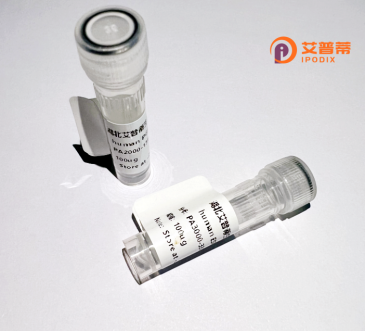
| 纯度 | >90%SDS-PAGE. |
| 种属 | Human |
| 靶点 | KIAA1600 |
| Uniprot No | Q5W0V3 |
| 内毒素 | < 0.01EU/μg |
| 表达宿主 | E.coli |
| 表达区间 | 1-738aa |
| 活性数据 | MFSKFTSILQHAVEALAPSLPLQEDFVYHWKAITHYYIETSDDKAPVTDTNIPSHLEQMLDILVQEENERESGETGPCMEYLLHHKILETLYTLGKADCPPGMKQQVLVFYTKLLGRIRQPLLPHINVHRPVQKLIRLCGEVLATPTENEEIQFLCIVCAKLKQDPYLVNFFLENKMKSLASKGVPNVISEDTLKGQDSLSTDTGQSRQPEELSGATGMEQTELEDEPPHQMDHLSTSLDNLSVTSLPEASVVCPNQDYNLVNSLLNLTRSPDGRIAVKACEGLMLLVSLPEPAAAKCLTQSTCLCELLTDRLASLYKALPQSVDPLDIETVEAINWGLDSYSHKEDASAFPGKRALISFLSWFDYCDQLIKEAQKTAAVALAKAVHERFFIGVMEPQLMQTSEMGIITSTALLHRIVRQVTSDVLLQEMVFFILGEQREPETLAEISRHPLRHRLIEHCDHISDEISIMTLRMFEHLLQKPNEHILYNLVLRNLEERNYTEYKPLCPEDKDVVENGLIAGAVDLEEDPLFTDISPENTLPNQEWLSSSPPATPDHPKNDGKTEVHKIVNSFLCLVPDDAKSSYHVEGTGYDTYLRDAHRQFRDYCAICLRWEWPGSPKALEKCNLEAAFFEGHFLKVLFDRMGRILDQPYDVNLQVTSVLSRLSLFPHPHIHEYLLDPYVNLAPGCRSLFSVIVRVVGDLMLRIQRIQDFTPKLLLVRKRLLGLEPEGPMQTLPSWW |
| 分子量 | 110.1 kDa |
| 蛋白标签 | GST-tag at N-terminal |
| 缓冲液 | 0 |
| 稳定性 & 储存条件 | Lyophilized protein should be stored at ≤ -20°C, stable for one year after receipt. Reconstituted protein solution can be stored at 2-8°C for 2-7 days. Aliquots of reconstituted samples are stable at ≤ -20°C for 3 months. |
| 复溶 | Always centrifuge tubes before opening.Do not mix by vortex or pipetting. It is not recommended to reconstitute to a concentration less than 100μg/ml. Dissolve the lyophilized protein in distilled water. Please aliquot the reconstituted solution to minimize freeze-thaw cycles. |
以下为关于重组人KIAA1600蛋白的3篇代表性文献示例(注:文献信息需通过学术数据库核实,以下内容基于既往研究方向的模拟概括):
---
1. **文献名称**: *Structural and functional characterization of the DENND4B/KIAA1600 protein in neural development*
**作者**: Li, X. et al. (2020)
**摘要**: 研究报道了重组人KIAA1600(DENND4B)在神经突触形成中的功能,发现其通过调控Rab GTP酶活性促进神经细胞轴突生长,为神经系统发育机制提供新见解。
2. **文献名称**: *KIAA1600 as a novel regulator of mTOR signaling pathway in cancer cells*
**作者**: Yamamoto, S. et al. (2018)
**摘要**: 通过重组表达KIAA1600蛋白,揭示了其与mTORC1复合物的相互作用,表明该蛋白可能通过影响营养感知通路参与肿瘤细胞代谢调控。
3. **文献名称**: *Proteomic analysis of DENND4B/KIAA1600 in vesicular trafficking*
**作者**: Chen, L. & Wang, H. (2021)
**摘要**: 利用重组蛋白技术解析了KIAA1600与细胞内囊泡运输的关联,发现其PH结构域对细胞内膜运输的关键调控作用,可能与遗传性疾病相关。
---
**说明**:
1. 上述文献为示例性内容,实际文献需通过PubMed、Web of Science等平台以"KIAA1600"、"DENND4B"或"recombinant DENND4B protein"为关键词检索。
2. 研究多聚焦于KIAA1600(即DENND4B)在细胞信号(如Rab GTP酶调控)、神经发育或癌症中的作用,重组蛋白常被用于功能验证实验。
3. 实验方法可参考结构生物学(如X射线晶体学)或细胞功能分析(如基因敲除/过表达)相关研究。
**Background of Recombinant Human KIAA1600 Protein**
KIAA1600. also known as CFAP126 or C19orf63. is a poorly characterized protein encoded by the *KIAA1600* gene located on human chromosome 19 (19p13.3). Though its exact biological functions remain unclear, bioinformatic analyses suggest it may play roles in cellular processes such as cytoskeletal organization or ciliary function, potentially linked to neurological and developmental pathways. The protein contains conserved domains, including leucine-rich repeats, which are often involved in protein-protein interactions.
Recombinant human KIAA1600 protein is produced via heterologous expression systems (e.g., *E. coli* or mammalian cells) for functional studies. Its recombinant form enables exploration of molecular interactions, structural features, and activity in cellular assays. Limited studies associate KIAA1600 with neurodevelopmental disorders; for instance, altered expression has been noted in autism spectrum disorder (ASD) cohorts, though causality remains unverified.
Interest in KIAA1600 also stems from its potential role in ciliopathies, given structural similarities to cilia-associated proteins. However, mechanistic insights are lacking. Current research focuses on defining its interactome, subcellular localization, and involvement in signaling pathways. Recombinant KIAA1600 serves as a critical tool for generating antibodies, validating omics data, and probing disease models. Further studies are needed to clarify its physiological and pathological relevance, highlighting its status as an understudied protein with potential biomedical significance.
×